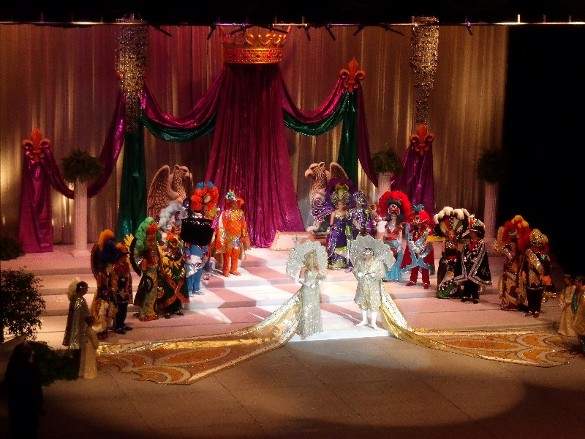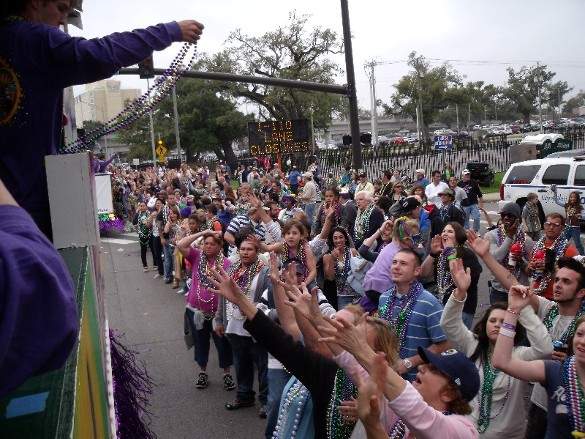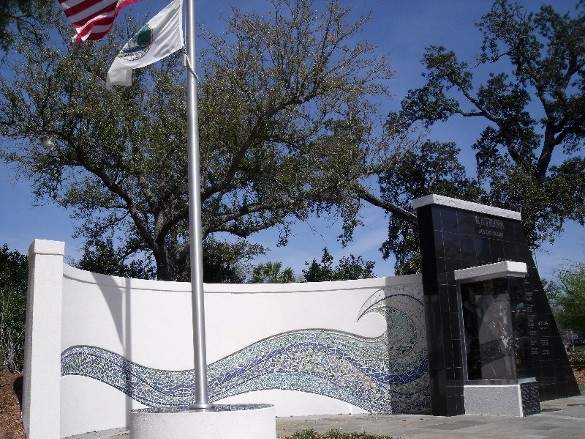In America, Mardi Gras (or Carnival) is so often associated with the goings on in New Orleans, even though many other cities along the southern coast of the USA have their own festivities, which are less intense and attended, and thus, more family-friendly and accessible.
Biloxi was the first Mississippi Gulf Coast city to have a full blown Mardi Gras parade that was sponsored by the city and its local businesses in 1908. This area had seen various ways of celebrating the pre-Lent season via balls, parties, and hell-raising before then. In 1891-92, the fire department had their own parades, but years would pass before anything like that would be seen again.
On March 3, 1908, 17 elaborately-displayed floats headlined a nighttime spectacle themed on the likes of a Japanese tea house, 18th century Biloxi, cat-themed “music” (a forerunner to Andrew Lloyd Webber’s Broadway spectacle?) and a beer garden. Regarding the latter, it’s ironic the state of Mississippi was in the midst of implementing statewide prohibition in 1908.
The next day’s newspaper proclaimed in its headline “Biloxi’s First Carnival A Success Beyond Expectations.” Predictions were made about another grand spectacle in 1909, but it wouldn’t be until 1912 that Carnival would again take hold of the city on Fat Tuesday.
103 years after the first major festivities, I had the opportunity to participate in the happenings of the grand parade and a tableau (a pageant) the night before. I saw that while the modern times shape Biloxi’s Carnival festivities, I still felt the roots of the past exposed in the sights and sounds of this occasion.
“Tableau out” the movies
The night before Fat Tuesday, the Gulf Coast Carnival Association held their annual coronation ball to honor the new King d’Iberville and Queen Ixolib (Biloxi spelled backwards). But the public, including me, was allowed free access to actually see the new royalty crowned at the MS Coast Coliseum. This was done amidst the theme of “Reel Travel,” where clips from classic movies like “Easy Rider,” “Top Gun,” and “Star Trek” were shown on two large screens to help introduce the colorfully-costumed royalty acting out the history of travel from ship and submarine to outer space. Later, Beethoven’s 9th Symphony would serenade in the crowning of King and Queen and the ensuing presentation of family members and dignitaries to the court.
As in “reel” life, to be a part of royalty (including the dukes and maids) means to be of the leading citizens in the area. For as the dukes (leading Mississippi Gulf Coast businessmen) were introduced, mini biographies of their alma maters, their business affiliations along with their yacht and tennis club associations were proclaimed over the PA system to us commoners. The maidens consisted of high-achieving college students who had previous ties to Carnivals past.
Hoping to escape the oncoming rains
As the Tuesday afternoon parade approached, the skies were cloudy, and the forecast predicted rain by mid-afternoon unlike the one in 1908, where the sun shined brightly amidst warm temperatures complemented by a nice breeze. I, along with thousands of others, walked around what I counted about 100 floats from businesses like the Waffle House (which infiltrates Biloxi seemingly every other block), hospitals, attorneys, the Elks, etc. They contained folks dressed up in the Mardi Gras colors of purple, gold and green, if not dressed up more elaborately (like pirates).
Some Krewes had the names of Tipplers, Unpredictables, Party Gras, and Who-Dat Nation (New Orleans Saints fans, which are plentiful in Biloxi). I didn’t see any Krewes dressed up like demons, as was the case in 1837 New Orleans, when one such group did that, inspired by Milton’s ‘Paradise Lost.’ That demonic crew would inspire carnival organizations being called “Krewes” (the “K” is an Old English addition).
We satisfied our curiosity about what the spectators would see on the parade route as loud rap, hip hop, and classic rock music blared. The alcohol was already a-flowing, yet the participants were generally well behaved.
The float I was to ride on was full of boxes. These boxes weighed 25 to 30-plus pounds each and contained 10-15 dozen strands of beads of various colors, hopefully to be all thrown out to the screaming crowds on a parade route expected to last at least two hours, which ran in front of historical buildings and on the coast road. Even though the parade began around 1pm, our float didn’t begin moving until about 45 minutes later (we were Number 66) onto Main Street, where immediately the screams for more beads could be heard.
“Throw me something, mister”
Over those two hours, I opened up sack after sack of beads and tossed them out to the masses (estimated to be around 100,000 people), who were often just inches away from our floats on much of the parade route, their hands, toy spears or nets outstretched. Yet I tried to throw my beads with purpose, aiming them at those who looked like they didn’t have as much, were in wheelchairs, or little kids whose facial expressions were hard to say no to. Floats tend to be crowded, and I was always wary of hitting the person next to me or being hit myself during an attempted throw as empty boxes and plastic sacks piled up all over the floor. In Carnival celebrations past during the 19th century, those on floats had to actually worry about miscreants throwing things back!
I’ve thrown the beads out at other Mardi Gras, and did notice some differences in Biloxi’s participants. They are generally less aggressive and don’t cry out verbally, “Throw me something, mister,” for I saw more signs with that verbiage than I heard yelled out. I also noticed more people with boxes and large garbage bags, collecting those beads, coins, and stuffed toys tossed to them as if they were loading up sacks for Santa Claus’ sleigh. But with almost 100 floats throwing, one could really cash in on the goodies.
Luckily for me, the float I was on was covered in case that rain did show up, which it didn’t until a half hour after we were finished throwing.
Biloxi Recommendation
I took the free, self-guided Historic Heart of Biloxi Walking Tour. I got the chance to see some 20 historic buildings and homes in the downtown area (dating from 1840) as well as the impressive Katrina Memorial, whose top height reflects the storm surge depth. Depending on how fast you walk and ponder the structures, give yourself 60-90 minutes time. Free maps are currently available at the Bond-Grant House on 932 Howard Ave., which serves as the temporary Visitors Center
All photos courtesy of the author and may not be used without permission.
Roy A. Barnes was part of a press trip sponsored by the Mississippi Gulf Coast Convention & Visitors Bureau, but what he wrote are his own impressions without any vetting from the press trip sponsor. He writes from southeastern Wyoming.



